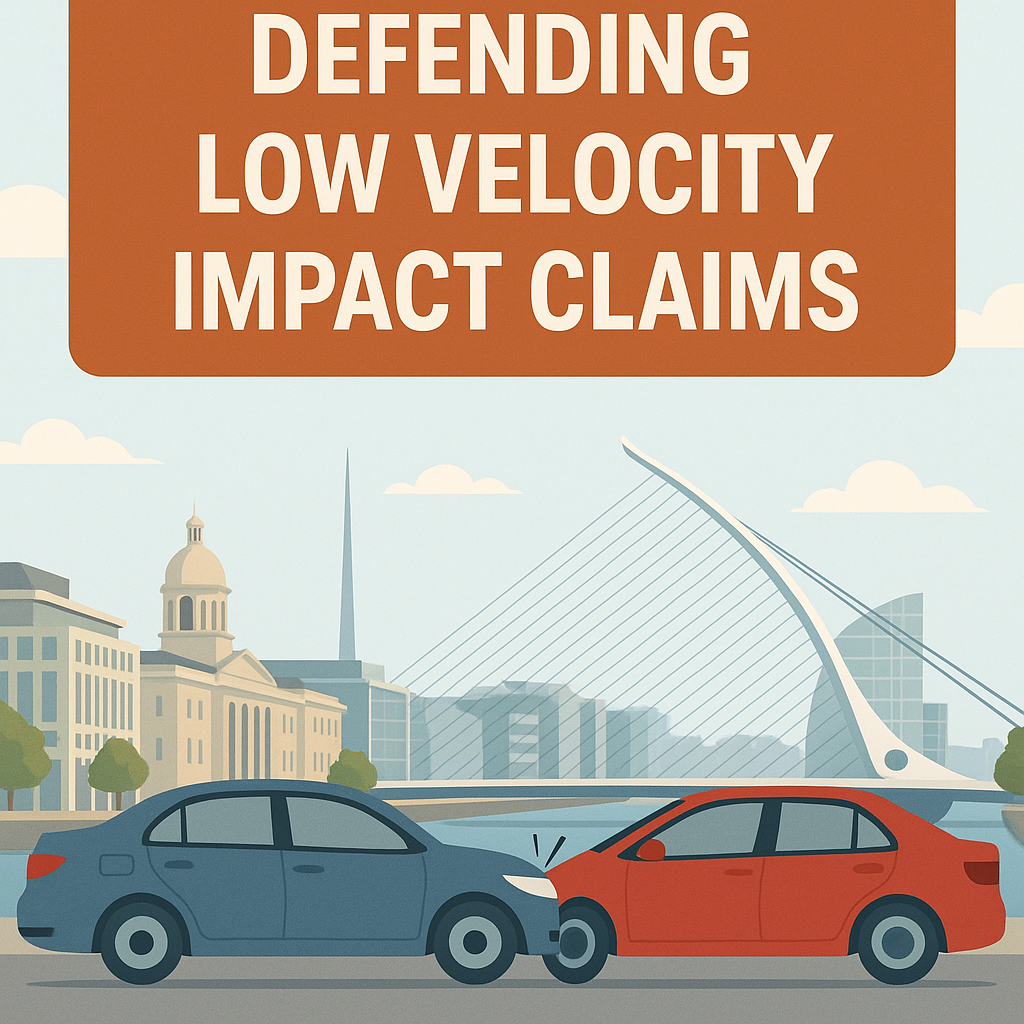When a driver suddenly loses control behind the wheel—spasms take over, reflexes override intention, or full unconsciousness sets in—courts may entertain the rare defence of “automatism.” At Lacey Solicitors, acting for motor insurers across both Northern Ireland and the Republic of Ireland, we advise on the merits of the Defence of Automatism in Motor Claims time and again.
Judgments in Northern Ireland, England and the Republic of Ireland all remind us that automatism remains a tightly confined exception in civil law: it applies only where a driver’s mind truly surrenders control of the body, without any warning or possibility of self‑intervention.
The Common‑Law Roots of Automatism in Motor Claims
Bratty v Attorney General for Northern Ireland was a Criminal Case, where Lord Denning described an automatic act as one done “by the muscles without any control by the mind” or by someone “not conscious of what he is doing.” That foundational definition has travelled into civil courts on both sides of the Irish border over the years.
Twenty years later, Roberts v Ramsbottom, [1980] 1 All ER 7 sharpened the knife: a driver escapes liability only if his loss of control was complete. Any flicker of awareness—if the driver still held even imperfect command of the wheel—means the defence collapses. In essence, Roberts treats civil automatism much like its criminal counterpart, requiring absolute involuntariness.
Mansfield’s Shift: From Culpability to Negligence
The English Court of Appeal’s 1998 decision in Mansfield v Weetabix offered a more nuanced path. Rather than asking whether the driver was morally culpable, Mansfield focuses on whether he breached the duty of care owed to other road users. If a driver is genuinely unaware—and could not reasonably have been aware—of an incapacitating medical condition, negligence is not made out. This approach avoids slipping into strict liability for unforeseeable medical emergencies.
Counihan v Bus Átha Cliath: Ireland’s Definitive Statement of Automatism in Motor Claims
In the Irish High Court’s 2005 ruling Counihan v Bus Átha Cliath, the bus driver at fault suffered an unexpected blackout caused by sick‑sinus syndrome—an arrhythmia that often strikes without warning. Medical experts confirmed the driver had experienced a total loss of consciousness at the moment of impact.
Judge Clarke in his decision, considered both English cases namely the rigid Roberts standard and the more flexible Mansfield test. He found that, even under the stricter rule of automatism in motor claims, automatism prevailed: there was no glimpse of control to hold the driver negligent. And under Mansfield, the driver had neither the knowledge nor any reasonable ground to suspect his heart condition, so no breach of duty arose.
When Automatism Will—and Won’t—Succeed
Across Northern Ireland and the Republic, case‑law relating to automatism in motor claims threads a consistent theme:
- Burden of Proof. The defendant must establish automatism on the balance of probabilities. This is a high threshold, particularly in civil claims where the consequences for claimants can be severe.
- Total vs. partial control. Automatism only applies if the defendant’s mind abandons control altogether. Any residual awareness or ability to steer—even poorly—undoes the defence (see Broome v Perkins, where a diabetic driver retained enough control to be held liable).
- Foreseeability. Under Mansfield, insurers should ask: could the driver have known of the condition? A history of episodes, medical warnings or missed prescriptions will erode the defence. Courts closely examine whether the loss of control was truly unforeseeable. In Green v Haynes [2014], the court rejected the defence where the defendant had felt unwell earlier in the day and chose to drive.
- Evidence‑intensive. Medical records, expert testimony and precise accident timelines are vital. Insurers must scrutinise GP notes, hospital admissions and any prodromal symptoms—dizziness, ringing in the ears, visual disturbances—that might suggest the driver should have stopped.
- Licensing duties. Drivers owe an ongoing obligation to inform the DVLA (in Northern Ireland) or the NDLS (in the Republic) of relevant medical conditions. Failure to declare can undermine the argument of unforeseeability.
Tips for Insurers from Lacey Solicitors Road Traffic Accident Specialists
When we advise on the merits of automatism defence we consider the following:
- Gather the medical evidence. Request full disclosure of GP and hospital records, prior diagnoses and prescriptions pre-proceedings. In NI there is a mechanism by virtue of Section 31 of the Administration of Justice Act 1970 and Order 24 Rule 8 of the Rules of Court of Judicature to obtain relevant notes and records prior to the issue of proceedings.
- Map the accident timeline. Pinpoint the exact moment of incapacitation through CCTV, telemetry data or eyewitness accounts.
- Engage specialists early. Cardiologists, neurologists or endocrinologists can address both blackout causation and warning signs.
- Probe licensing disclosures. Confirm whether the driver properly notified licensing authorities of any condition that could impair driving.
- Challenge prodromes. Look for any evidence—however fleeting—of pre‑accident symptoms that a reasonable driver would heed.
Crafting a Robust Defence Pleading
When raising automatism as a defence, it is essential to plead the facts and legal basis with clarity and precision. A typical formulation in a Defence may read as follows:
Denial of Negligence and Plea of Automatism
In the context of the foregoing admissions, it is denied that the Deceased was negligent, whether as alleged by the Plaintiff or otherwise howsoever characterised.
The Defendants will aver that, immediately prior to the collision, the Deceased was suddenly and without warning overcome by a total, involuntary, and disabling medical event, the effect of which was to deprive him of any conscious control over his actions.
It is denied that the Deceased was in breach of any duty of care owed to the Plaintiff, whether at common law or otherwise.
This approach ensures that the defence is properly articulated and that the factual and legal basis for denying negligence is clear.
Policy Gaps and the Need for Reform
While the Motor Insurers’ Bureau (MIB) in the UK and its Irish counterpart the MIBI provide vital compensation for victims of uninsured or untraced drivers, a troubling gap remains in both jurisdictions: there is no dedicated scheme for victims injured by drivers who suffer unforeseeable medical emergencies. When the defence of automatism is successfully raised, even fully insured drivers may be absolved of liability—leaving blameless victims without any recourse to compensation.
This legal reality is particularly harsh for pedestrians, passengers, and other road users who suffer serious, sometimes life-altering injuries through no fault of their own. Unlike victims of uninsured drivers, they cannot turn to any statutory fund or fallback scheme. Their suffering is real, their losses are profound, yet the law offers no remedy.
In Counihan, Clarke J. acknowledged this troubling gap with clarity and compassion:
“Victims struck by drivers who suffer unforeseeable medical emergencies have no dedicated compensation scheme. Unlike collisions involving uninsured motorists, these innocent pedestrians and passengers cannot turn to any special fund.”
He went on to note that addressing this gap is a matter for the Irish Government and not the courts. This observation underscores the limitations of judicial intervention and the urgent need for legislative reform.
Jurisdictions such as New Zealand have already taken steps to address this issue through no-fault compensation schemes, ensuring that victims are supported regardless of fault. Such models offer a blueprint for reform in Ireland and the UK—one that prioritises fairness, compassion, and public confidence in the legal system.
Conclusion
At Lacey Solicitors, we believe that the law must evolve to reflect the realities faced by innocent victims. While the defence of automatism in motor claims serves a legitimate legal function, it should not operate as a barrier to justice. We support calls for a statutory compensation scheme that ensures no victim is left behind simply because the driver who caused their injuries was not at fault.
Automatism in civil motor claims remains an exception so narrow it often feels razor‑edged. Lacey Solicitors stays at the cutting edge—monitoring new judgments, refining evidential strategies and balancing the interests of insurers against the real plight of victims caught in unforeseeable medical crises. By combining rigorous medical scrutiny with a deep understanding of Roberts, Mansfield and Counihan, we ensure that the defence of automatism is reserved solely for those rare cases where a driver’s mind truly, utterly lets go.
For further insights, contact our team in Belfast & Dublin using our online portal.

















